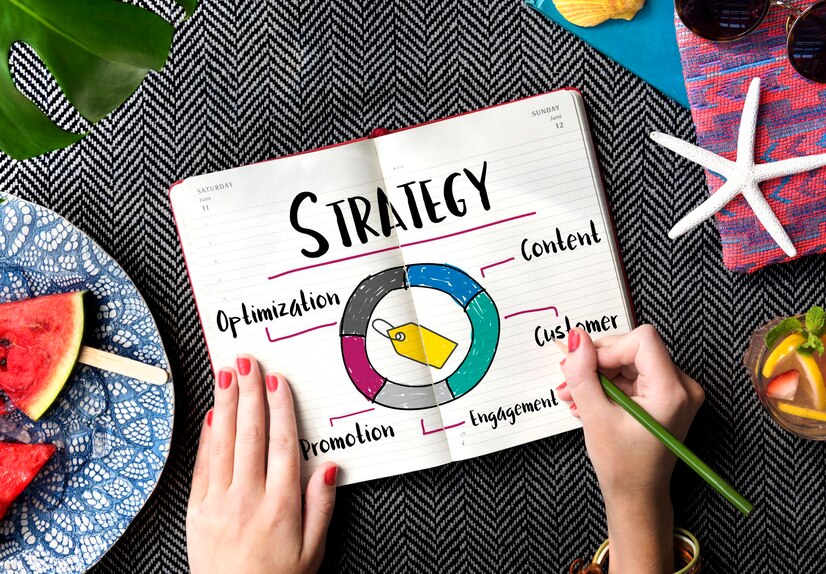7 Surprising Marketing Strategies You Need to Try Today

With the rapid growth of technology and the always shifting needs of consumers, marketers must devise practical strategies to effectively market and sell their goods and services. A factor that is frequently disregarded in addition to strategy formulation is selecting effective marketing instruments that may produce quantifiable outcomes. Your target audience’s needs and the products you wish to sell them are the only factors that should guide your choice of marketing approach. Here are seven popular approaches or platforms that will be popular in the upcoming year: Video Promotion (Short-Form Contents) Today’s marketers struggle with short attention spans, and when you consider the big picture, this is contributing to the poor performance of their current digital strategy. They can, however, swing the balance to their advantage. However, the issue remains: How can marketers differentiate themselves in a sea of millions of content pieces produced daily? by utilizing imaginative videos that have a five-fold increase in engagement and show far more promise for converting viewers. According to Oberlo, 93% of marketers claim to have used social media videos to acquire a new client. Top international businesses like CRED, Asana, Vicks, and others have found incredible success with these social media videos, which have received an absurd amount of views in a matter of 30 to 45 seconds. Therefore, if you’re a tech entrepreneur or SaaS marketer, you need to be aware that your rivals are already employing innovative films to explain and advertise their sophisticated products. Content Marketing This is a combination of several marketing products meant to inform and encourage a target audience to purchase a good or service. These primarily consist of case studies, films, infographics, blog entries, articles, e-books, and testimonials. A recent statistic indicates that 91% of marketers who have used a content marketing approach have found success. Neil Patel, for example, has emerged as one of the digital marketing industry’s most successful figures. We’ve seen that he targets his audience or educates them through blog articles and videos. In order to draw in and keep the intended audience, his marketing approach entails consistently producing and disseminating insightful and pertinent content. Are you wondering what’s meant by “high-quality content”? It describes content that stands out from the competition and effectively communicates your message to the intended audience. It may surprise you to learn that a lot of SaaS and B2B companies, including Asana, Freshworks, AWS, and others, still choose writing lengthy blogs centered upon their product keywords. It follows that you should start penning informative articles that inform potential customers and provide them a preview of the difficulties your solution may solve. You can utilize tools like an outline generator, text rewriter, keyword generator, etc. while writing to enhance your written content’s quality. If executed finely, content marketing has the potential to take a business to new heights single-handedly. Email Marketing Top marketers use this approach as their main means of generating leads for their company or brand. The following practical advice will help you make the most of your data when managing campaigns: Endeavor to send emails at the proper time and day. The ideal days are business days, and the hours that are advised are from 1 PM to 3 PM and from 9 AM to 11 AM.Provide one or two pertinent links that take recipients to the required pages on your website.By automating and customizing your communication, email campaigns that integrate a CRM with them might further improve your approach.Many firms are increasingly using 10-to 15-second videos, or “Vmails,” into their email marketing. You might try adding these to increase response rates or conversions. Utilizing the most recent email marketing trends, you can approach prospective leads or customers with individualized emails that increase the likelihood that they will be piqued and convert to regular paying clients. Social Media Marketing Social media content creation is one of the most vulnerable and, conversely, an opportunistic sector for marketers to penetrate. From an opportunity standpoint, however, marketers are using a variety of social media techniques to raise brand awareness and drive traffic to their company websites. For instance, in an effort to improve customer engagement, many organizations have completely reoriented their social media content narrative from being brand-centric to customer-centric. They have started making animated ads and social media postings that provide people with direct, interesting, and educational answers to their questions. Additionally, a lot of firms have started one-on-one conversations with customers on popular platforms like Facebook, Instagram, X [previously Twitter], etc. Customers feel acknowledged by this two-way dialogue, which also improves their perception of the brand. Influencer Marketing Marketers are expected to spend over USD 7.14 billion on influencers by 2024, according to Insider Intelligence. Given the amount of money brands spend on influencers, they should consider recruiting influencers who align with their target market, line of products, and marketing objectives. With so many resources at their disposal—UpFluence, Klear, LinkedIn, Influencity, and more—marketers may launch their brand campaigns by strategically partnering with relevant influencers. In 2023, companies that offer groceries and healthcare services boosted online traffic and converted viewers by including their items in videos that prominent influencers posted. Selecting an influencer with a sizable fan base is essential for effective influencer marketing. If you’re a marketer or a corporation with a limited budget, this could be challenging. Optimization for Search Engines Google Search’s content preference, quality, and user experience have all undergone dynamic changes. Significant algorithmic changes that prioritized continuously enhancing the caliber of material posted by websites on Google and the general search experience on its platforms were implemented in 2023. What therefore ought to be in mind in 2024 as you’re planning your SEO and digital marketing strategy as a whole? Here are some guidelines: Furthermore, Google’s emphasis on providing the best responses to user inquiries has radically changed since the new “E” for Experience was added to the EAT concept in December 2022. Not to mention, Google has publicly endorsed the usage of AI-generated content with the stipulation that it
Master Digital Success: 7 Steps to an Unstoppable Digital Marketing Strategy

Just like in everything in life, if you don’t have a plan, the complexity of online marketing can seem overwhelming and quickly demoralize you. This is where a well-crafted digital marketing strategy can help. With a clear strategy, you can turn the pain of having a small online presence into the joy of having high engagement and conversion rates. In this article, we’ll walk you through the process of creating a digital marketing strategy for your business. What is a digital marketing strategy? An all-encompassing plan that describes how a company will use online channels including search, social media, email, and content marketing to accomplish its marketing objectives is called a digital marketing strategy. It acts as a roadmap, directing your marketing efforts in the direction of achieving your company’s goals. This plan of action consists of several elements, such as the following: How to Build a Digital Marketing Strategy Having a digital marketing strategy is very essential in the internet-driven world of today. Companies of many kinds, in a range of sectors, are using digital marketing to connect with their target market, advertise their goods and services, and eventually spur growth and profitability. Digital marketing, however, entails more than just slinging stuff online and hoping for the best. It involves creating a deliberate, all-encompassing strategy that takes into account your target market, objectives, rivals, and the particular characteristics of every digital platform. It involves coordinating your strategy with your overarching business goals and modifying your approach in response to performance information. Even though it could be difficult, this procedure is essential for any company hoping to thrive in the digital landscape Regardless of the sector your company operates in—home services or health—you need to have a digital marketing plan to make sure clients can find and choose your company. It could seem overwhelming to start the process of developing your digital marketing plan. But it becomes a lot easier when you take an organized approach and divide it into small steps. This post will walk you through each phase, providing guidance and insights to help you create a solid and successful digital marketing plan. Now let’s get started and investigate the realm of developing digital marketing strategies! 1. Determine Who Your Audience Is Understanding and identifying your audience is the first step in developing a digital marketing plan. This entails identifying the traits of the individuals who are most likely to find your product or service interesting. While demographic information like age, gender, income, and geography can be gathered, it’s as critical to comprehend the habits, interests, and issues that your audience faces and needs to be resolved. For instance, a nearby bakery might focus on the needs of working parents in the neighborhood who prioritize convenience and are searching for quick, simple, and delectable dinner ideas. However, a software business that provides a fitness tracking app might target tech-savvy, health-conscious millennials who exercise outside of the gym and follow fitness celebrities on social media. Remember that understanding your customer is fundamental for a successful marketing. To better understand your audience and focus your digital marketing efforts on meeting their unique wants and preferences, you can develop thorough buyer personas. 2. Establish Your Objectives and Goals Clearly defining your goals for your digital marketing plan is the next stage. Setting SMART goals—Specific, Measurable, Achievable, Relevant, and Time-bound—is essential. Your aims should be in line with your company’s overarching ambitions. For instance, an online clothes retailer may want to use content marketing and SEO to boost website traffic by 50% over the course of the following six months. By using targeted social media marketing, a nearby restaurant may seek to increase online reservations by 20% in the upcoming quarter. Recall that every business has distinct objectives. Establishing your goals up front gives your digital marketing initiatives focus and enables you to track your progress. 3. Assess Your Competitors You can comprehend the state of your industry, spot important trends, and spot chances to set your company apart from the competition by doing a thorough competitor study. Examine your rivals’ pricing, marketing approaches, and client experiences, as well as how they present themselves. For instance, if you run a software-as-a-service company that provides project management solutions, you may discover that your rivals have robust content marketing plans, a strong emphasis on sponsored search advertisements, and round-the-clock customer service. Make use of this information to identify and exploit any weaknesses in their approach. Choose the Channels for Your Digital Marketing Your target demographic and your objectives should guide the digital marketing platforms you select. Search engine optimization (SEO), pay-per-click (PPC), email, social media, content, and email marketing are a few examples of these. A B2B software business, for instance, would concentrate on LinkedIn for social media marketing, use SEO to increase organic traffic, and nurture leads using email marketing. In contrast, a B2C e-commerce company may make significant investments in email marketing to retain customers, PPC advertisements for quick exposure, and Instagram and Facebook ads. Every channel has a different set of benefits and calls for a different strategy. Through comprehension of each one and its potential advantages for your company, you may develop a multi-channel digital marketing plan that maximizes your reach and impact 5. Describe Your Content Plan The foundation of any successful digital marketing plan is content. It cultivates leads, increases brand recognition, educates consumers, increases traffic, and turns prospects into customers. The kinds of material you will produce, the subjects you will cover, the platforms you will utilize, and the frequency of your publications should all be specified in your content strategy. A health and wellness blog, for instance, might publish a variety of content, including workout videos, how-to articles, personal success stories, and educational pieces about diet and fitness. They might distribute these through email newsletters, social media, and their website. The audience should always receive value from the material, which should attend to their requirements, respond to their inquiries, and assist them in reaching their
Turn Mistakes into Opportunities: 10 Digital Marketing Mistake to fix

Since the internet has become so prevalent in our lives, your company needs to adapt as well. Digital marketing can help with brand building, product or service promotion, and business promotion. You have a reputation to establish and a viewership to reach on the internet. But like anything else, there are right and bad ways to use digital marketing. Make sure you are doing things correctly by looking over these typical digital marketing mistakes. 1. Absence of a Blog Recall that your goal is to position oneself as a reliable industry leader in addition to trying to promote your website as a business. Putting out insightful, useful, and easily readable blog posts will make you a reliable voice. Furthermore, every blog post you write adds to your site’s index, and the more indexed pages you have, the higher your site will appear in Google search results. It’s crucial that the blog be participatory in addition to being created. To get answers, post questions in the comment box. Include guest pieces or interviews with scholars or accomplished experts in your sector as well. Make the most compelling post possible every time by using this blog post writing guide. 2. Avoiding social media It’s possible that you believe you can avoid using social media. I regret to inform you that you are mistaken! It’s a vital strategy for converting leads into paying clients. You may advertise your business online by disseminating your content, connecting with consumers, and reaching your audience. Understand why you require a social media manager before attempting to handle everything yourself. 3. Ignoring Mobile Users Worldwide, mobile browsing makes for over 50% of all web traffic. In order to ensure that the load time on mobile devices is just as quick as it is on desktops, remember to optimize your website for mobile visitors as well. Make sure your website’s design has been modified for mobile viewing as well. 4. Not Offering Sales and Discounts According to a Retail Me Not poll, 2/3 of consumers made an impulsive buy just because there was a discount. Limited-time deals or online coupons make excellent pop-ups for your website, particularly when they appear on the landing page or when a visitor would quit their shopping. There should be a call-to-action on your website that is rewardable with a promotion. 5. Not Making Enough Use of Keyword Research You must prioritize SEO if you want potential clients to be able to locate you online. Determine which keywords are most popular, highly relevant, and somewhat straightforward to rank for. Next, keep an eye on your ranking for every term, the quantity of traffic each keyword generates, and whether the visitors are coming from that keyword are turning into leads. 6. Aiming for a Wide Audience It is not an economical use of your funds to use your marketing budget to reach as many individuals as possible. Select a target market that is well-defined and will provide more pertinent leads. Never assume anything about any audience or base your decisions on educated guesses. To identify your target audience and the most effective approach to contact them, conduct research. 7. Having a Badly Designed Website A call to action and a landing page with optimal optimization are essential components of every website built with digital marketing in mind. Discounts and promos must to be prominently displayed as well. It is crucial to have an engaging and educational website if you want to convert visitors into qualified leads. 8. Failing to Monitor Your Leads Numerous traffic sources, including social media, email blasts, referring links, and keywords, can produce online leads. While one of those sources may regularly produce clients, the other may only occasionally produce leads. It’s critical to understand this so that you may modify your approach appropriately. 9. Disregarding other Competitors There’s a good chance that someone else is providing the same service as you. Instead of acting as though they don’t exist, figure out how to make an impression. Determine your brand’s unique selling point and emphasize it on your website. Your website should make it very evident what sets you apart from the competitors. 10. Not Making Use of Social Proof Seeing instances of contented consumers inspires greater conversions. Case studies, success stories, and testimonials reassure visitors to your website that other customers are satisfied with your company. They have peace of mind knowing that they will be. GET IN TOUCH Boost your brand’s digital presence with Dgazelle! As your dedicated growth partners, we craft personalized digital marketing strategies that resonate with your audience, elevate engagement, and deliver tangible results. Let’s get started today!
Understanding Click Funnels vs. Sales Funnels

Introduction In today’s digital landscape, where consumer behavior is constantly evolving, businesses must employ effective marketing strategies to stay competitive. Among these strategies, the concept of funnels has emerged as a fundamental framework for guiding potential customers through the purchasing journey. In this blog post, we’ll delve into the world of funnels, comparing the functionality of Click Funnels with traditional sales funnels, and exploring their respective roles in modern marketing. Overview of Click Funnels and Sales Funnels Let’s start by clarifying what we mean when we refer to Click Funnels and Sales Funnels. Click Funnels: Click Funnels is a comprehensive software platform developed to simplify the process of creating, managing, and optimizing sales funnels. Founded by Russell Brunson in 2014, Click Funnels has gained widespread popularity among entrepreneurs and marketers for its user-friendly interface and powerful features. Sales Funnels: On the other hand, sales funnels, in a broader sense, encompass the strategic framework businesses use to guide potential customers through various stages of the buying journey. This traditional approach predates the advent of dedicated funnel-building software and involves crafting a series of steps aimed at converting leads into paying customers. Importance of Funnels in Marketing Why are funnels so crucial in modern marketing practices? Let’s explore their significance: Streamlining the Customer Journey: In today’s fast-paced digital world, consumers are inundated with choices. Funnels provide a structured pathway for guiding prospects from initial awareness to final purchase, making the buying process more efficient and intuitive. Addressing Customer Needs: Effective funnels are tailored to meet the specific needs and preferences of target audiences at each stage of the buyer’s journey. By understanding customer pain points and motivations, businesses can create compelling content and offers that resonate with their audience. Maximizing Conversions: At its core, the purpose of a funnel is to drive conversions. Whether it’s capturing leads, nurturing prospects, or closing sales, a well-designed funnel optimizes every touchpoint to encourage action and drive revenue. What are Sales Funnels? At its core, a sales funnel represents the journey that a prospect takes from initial awareness of a product or service to making a purchase. Just like a traditional funnel, it begins with a wide opening, capturing the attention of a broad audience, and gradually narrows down as prospects progress through various stages, ultimately leading to conversion. The concept of a sales funnel is rooted in the understanding of consumer behavior and psychology. It acknowledges that not all prospects are ready to buy immediately and recognizes the importance of nurturing relationships and building trust over time. Image Source: Freepix Components of a Sales Funnel A typical sales funnel consists of several key components, each serving a specific purpose in guiding prospects towards conversion: 1. Awareness: This is the top of the funnel, where prospects become aware of your brand, product, or service. It’s crucial to create compelling content and marketing campaigns to attract attention and generate interest. 2. Interest: Once prospects are aware of your offering, they move to the interest stage, where they seek more information and engage with your content. Providing valuable resources, such as blog posts, videos, and guides, can help nurture their interest and keep them engaged. 3. Consideration: In this stage, prospects are evaluating their options and considering whether your offering meets their needs. It’s essential to address their concerns, highlight your unique selling propositions, and provide social proof, such as customer testimonials and case studies. 4. Decision: As prospects move closer to making a purchase, they enter the decision stage, where they weigh the benefits and drawbacks of choosing your product or service. Offering incentives, such as discounts or free trials, can help incentivize them to take the final step. 5. Action: This is the bottom of the funnel, where prospects take the desired action, whether it’s making a purchase, signing up for a trial, or requesting more information. It’s essential to make the conversion process as seamless as possible and provide clear calls-to-action to encourage action. Purpose and Benefits The primary purpose of a sales funnel is to guide prospects through the buying journey and maximize conversions. However, sales funnels offer several additional benefits, including: – Improved Lead Quality: By qualifying leads at each stage of the funnel, businesses can focus their efforts on prospects who are most likely to convert, thereby improving overall lead quality. – Increased Conversion Rates: By optimizing each stage of the funnel and addressing the specific needs of prospects, businesses can increase conversion rates and drive more sales. – Better Customer Insights: Sales funnels provide valuable insights into customer behavior, preferences, and pain points, allowing businesses to refine their marketing strategies and tailor their offerings to better meet customer needs. Understanding Click Funnels Click Funnels is an all-in-one software platform designed to simplify the process of building, managing, and optimizing sales funnels. Developed by Russell Brunson and his team in 2014, Click Funnels has gained immense popularity among entrepreneurs, marketers, and businesses of all sizes for its user-friendly interface and robust features. Key Features of Click Funnels: 1. Drag-and-Drop Funnel Builder: Click Funnels offers an intuitive drag-and-drop editor that allows users to create custom sales funnels without any coding knowledge. Users can choose from a variety of pre-designed templates or build their funnels from scratch. 2. Pre-Built Templates: Click Funnels provides a wide range of professionally designed templates for various industries and use cases, including lead generation, sales, webinars, and more. These templates are fully customizable, allowing users to tailor them to their specific needs. 3. Integrated Email Marketing: Click Funnels includes built-in email marketing automation features, allowing users to capture leads, send follow-up emails, and nurture prospects directly within the platform. This integration streamlines the lead nurturing process and helps drive conversions. 4. Payment Gateway Integration: Click Funnels seamlessly integrates with popular payment gateways, such as Stripe and PayPal, enabling users to accept payments and process transactions directly through their funnels. This feature simplifies the checkout process and reduces friction for
Brand Positioning using Storytelling Marketing Strategies

Introduction Many SMEs struggle to cut through the digital clutter and create a meaningful connection with their audience. The challenge lies in conveying their brand message in a way that resonates and leaves a lasting impression. In an era where attention spans are fleeting, the fear of being overlooked or failing to communicate your unique value proposition can hinder your business growth. Generic marketing messages often fall flat, and the struggle to stand out in a crowded marketplace becomes more apparent. This article serves as your guide to unlocking the potential of storytelling marketing strategies for SMEs. By the end, you’ll will learn how to create storytelling strategies that resonate and elevate your brand. Let’s embark on this journey to transform your marketing approach and leave a lasting mark on your audience. The Power of Storytelling in Marketing Storytelling is an age-old tradition that transcends cultures and generations. In the context of marketing, it is a powerful tool that goes beyond merely promoting products or services. Let’s explore why storytelling is a game-changer for SMEs looking to make a meaningful impact in the digital age. 1. Emotional Connection: Storytelling has a unique ability to evoke emotions. By weaving narratives that resonate with the human experience, you can create a deep emotional connection with your audience. Emotionally engaged customers are more likely to remember your brand and become loyal advocates. 2. Differentiation and Brand Identity: In a competitive market, standing out is crucial. Storytelling provides a platform to showcase what makes your brand unique. By conveying your values, mission, and brand personality through stories, you create a distinctive identity that sets you apart from competitors. 3. Memorable Messaging: Humans are wired to remember stories more than facts or figures. A well-crafted story becomes memorable, ensuring that your brand stays in the minds of your audience. This memorability contributes to brand recall and, ultimately, to customer retention. 4. Building Trust: Trust is the foundation of any successful business relationship. Through storytelling, you can build trust by being transparent about your brand’s journey, challenges, and successes. Authentic storytelling fosters a sense of transparency and reliability, strengthening the bond with your audience. 5. Engaging Content: Storytelling brings a narrative arc to your content, making it more engaging. Whether through blog posts, social media, videos, or other mediums, storytelling captures and sustains your audience’s attention. Engaged audiences are more likely to interact with your brand and convert into customers. The Storytelling Struggle: Why It Matters Before delving into the strategies of effective storytelling, let’s address the common challenges that SMEs face when attempting to incorporate storytelling into their marketing and why overcoming these hurdles is crucial for business success. 1. Lack of Cohesive Brand Narrative: If your brand messages lack coherence and a clear narrative, it becomes challenging for your audience to connect the dots. A disjointed brand story can confuse potential customers and dilute your brand identity. 2. Ineffective Use of Story Elements: Storytelling involves various elements like characters, plot, conflict, and resolution. Failing to effectively incorporate these elements into your brand narrative results in a story that falls flat or lacks the impact needed to engage your audience. 3. Difficulty in Audience Connection: Creating a connection with your audience requires understanding their needs, values, and aspirations. If your storytelling does not resonate with your target demographic, you risk alienating potential customers. 4. Lack of Consistency Across Platforms: Consistency is key in storytelling. If your brand story differs across platforms or marketing channels, it creates confusion. A cohesive and consistent narrative enhances brand recall and reinforces your messaging. Call to Action: Ready to transform your marketing approach and create compelling storytelling strategies? Our team specializes in crafting narratives that resonate with your audience. Contact us to discuss how we can help you elevate your brand through the power of storytelling. Crafting Effective Storytelling Marketing Strategies Now that we’ve identified the challenges, let’s delve into the strategies that can transform your storytelling marketing efforts into a powerful driver of brand elevation. 1. Know Your Brand Story: Start by understanding and articulating your brand story. What inspired the inception of your business? What challenges have you overcome, and what successes have you celebrated? Your brand story is the foundation of effective storytelling. 2. Define Your Brand Values: Your brand values shape the narrative of your stories. Identify the core values that define your business. Whether it’s a commitment to sustainability, customer-centricity, or innovation, these values should be woven into your storytelling. 3. Understand Your Audience: Effective storytelling is audience-centric. Know your target audience—their demographics, preferences, and pain points. Craft stories that resonate with their experiences and aspirations, fostering a sense of connection. 4. Incorporate Story Elements: Utilize the fundamental elements of storytelling—characters, plot, conflict, and resolution. Introduce relatable characters, highlight challenges your brand has faced, and showcase how you’ve overcome obstacles to create a compelling narrative. 5. Be Authentic: Authenticity is paramount in storytelling. Avoid embellishments or exaggerations. Share genuine stories that reflect the real journey of your brand. Authenticity builds trust and resonates with today’s discerning consumers. 6. Consistency Across Platforms: Ensure consistency in your brand narrative across all marketing channels. Whether it’s your website, social media, or email campaigns, a unified brand story reinforces your messaging and enhances brand recall. 7. Use Multiple Storytelling Mediums: Experiment with various storytelling mediums. From written content to visual elements like videos and infographics, diversify your storytelling strategy to cater to different audience preferences. 8. Encourage Customer Stories: Leverage customer testimonials and success stories. Incorporating real experiences from your customers adds credibility to your brand narrative. Share stories of how your products or services have positively impacted your customers. Elevating Your Brand Through Professional Storytelling While the strategies mentioned above are fundamental, the professional touch can significantly enhance the effectiveness of your storytelling marketing efforts. 1. Expert Story Crafting: Professional assistance in crafting your brand story ensures that it resonates with your audience and aligns with your business goals. Story crafting involves a deep understanding of narrative

